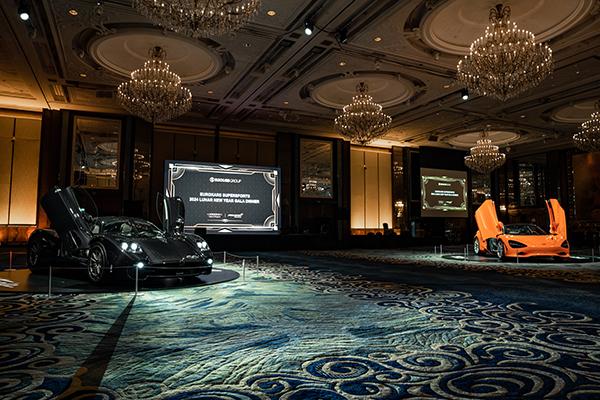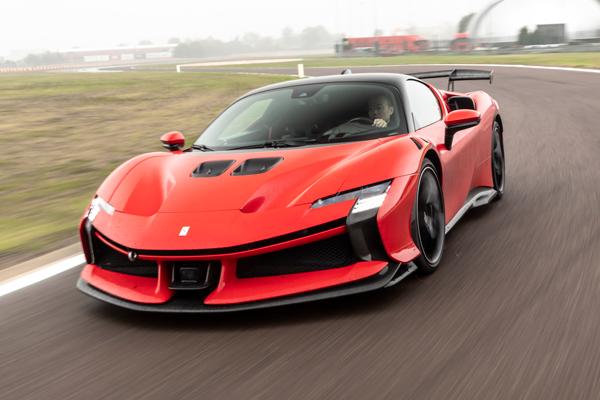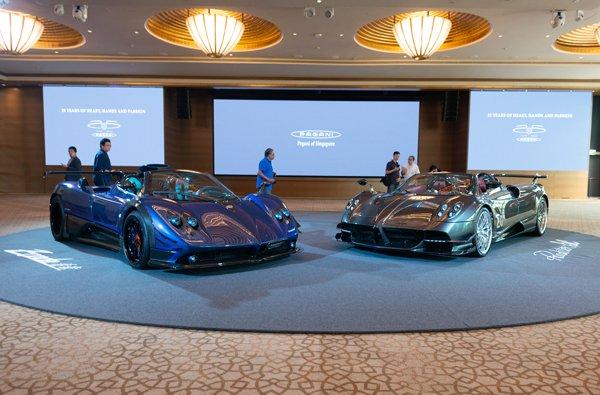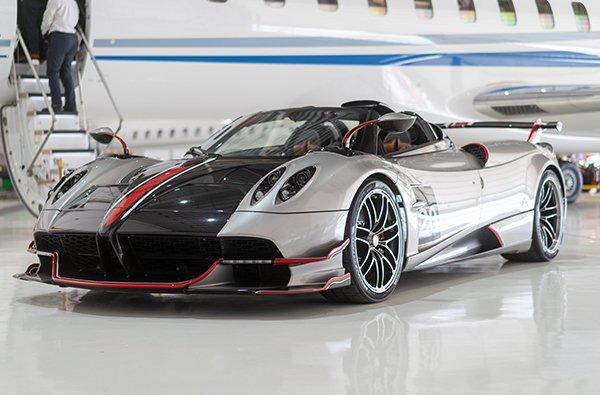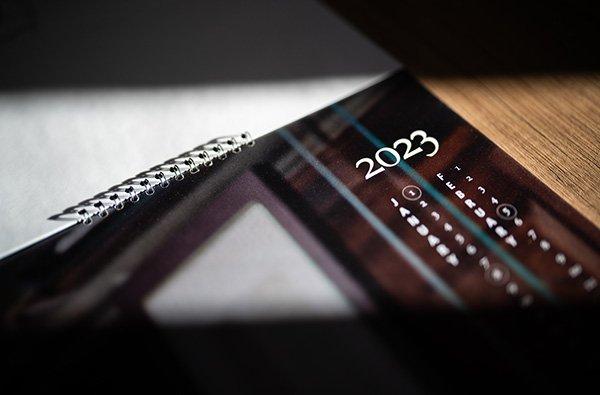Pagani releases Act III - The Utopia
14 Sep 2022|1,120 views
Pagani is a car company like no other. The Italian hypercar manufacturer which celebrates its 30th anniversary this year, has only just launched its third new car in the 30 years it has been in business. To put things into perspective, Ferrari launches around three all new cars in just a single year.
However, as we all know, quality triumphs over quantity in the world of Pagani. The Pagani Zonda and Pagani Huayra, the brand's first two cars, have been widely acclaimed as two of the finest cars to ever come out of Italy. To say that they imbue the very essence of passion and engineering excellence is an understatement to the genius that is Horacio Pagani.
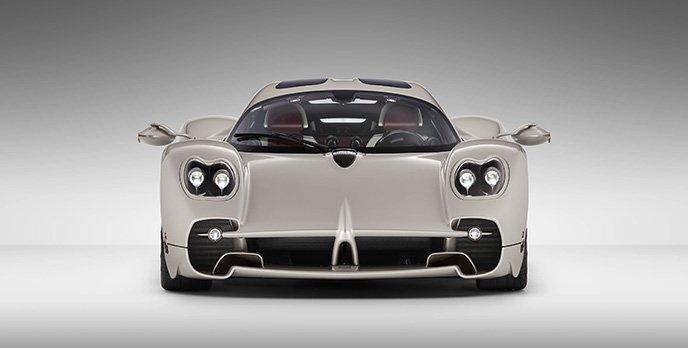
 The design combines the best elements of the Zonda and Huayra, creating a match made in heaven... or Utopia? Enough of waxing lyrical about Pagani, let's talk about their latest masterpiece, the Pagani Utopia. The Utopia, as Horacio Pagani put it, aims to do things differently from what other high-end car makers are currently doing. He singled out three key elements which were missing from most cars, simplicity, lightness and pleasure of driving.
The design combines the best elements of the Zonda and Huayra, creating a match made in heaven... or Utopia? Enough of waxing lyrical about Pagani, let's talk about their latest masterpiece, the Pagani Utopia. The Utopia, as Horacio Pagani put it, aims to do things differently from what other high-end car makers are currently doing. He singled out three key elements which were missing from most cars, simplicity, lightness and pleasure of driving.
Looking at photos of the Utopia, one of the key elements stands out: Simplicity. The Utopia has lines that are typical of a Pagani, but this time with more flowing and curvaceous design tones. The new car has very few aerodynamic add-ons but is more efficient than ever.
The Utopia incorporates the function of its appendices into its overall shape, achieving greater downforce and reduced drag solely by means of its design. This is unlike certain hypercars which possess numerous spoilers, disrupting the clean look of the car.
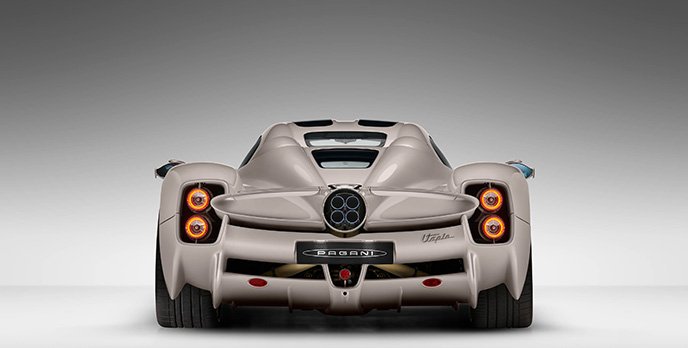
 New shape incorporates appendices into overall shape, acheiving greater downforce and reduced drag while maintaining pure, unadultered lines Forged wheels with a turbine-shaped carbon fibre extractor are present, drawing hot air away from the brakes and reducing turbulence under the body.
New shape incorporates appendices into overall shape, acheiving greater downforce and reduced drag while maintaining pure, unadultered lines Forged wheels with a turbine-shaped carbon fibre extractor are present, drawing hot air away from the brakes and reducing turbulence under the body.
They are mounted on carbon-ceramic discs, coupled to brake calipers which have a new, lightened design.
The iconic Pagani titanium quad exhaust layout, a feature found on no other car, makes a return on the Utopia. It has a ceramic coating in order to dissipate heat efficiently, setting the weight just above 6kg for the entire system.
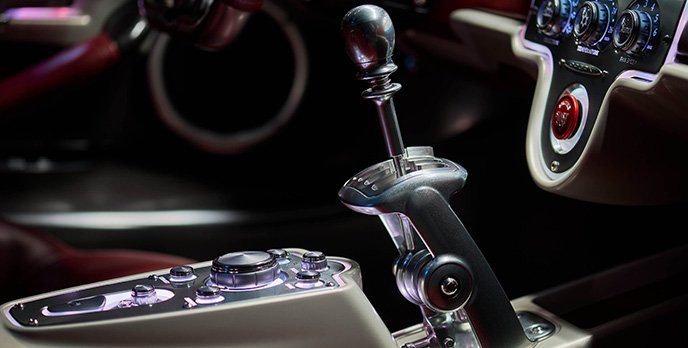
 The Utopia's gear shifter is pure Pagani with a skeletal-like movement which shows off the intricate mechanisms Moving on to the interior, Pagani claims that the cabin is more original than the car's exterior. There are no screens apart from the minimal display in front of the driver. The instruments are purely analog and each of the easy to read dials subtly reveals part of its mechanism as if it were revealing the skeleton movement.
The Utopia's gear shifter is pure Pagani with a skeletal-like movement which shows off the intricate mechanisms Moving on to the interior, Pagani claims that the cabin is more original than the car's exterior. There are no screens apart from the minimal display in front of the driver. The instruments are purely analog and each of the easy to read dials subtly reveals part of its mechanism as if it were revealing the skeleton movement.
The steering wheel is fashioned from a solid aluminum block, from the spokes and hollow rim to the steering column boss, which contains the airbag. The pedals are also made from a single block of metal, while the gear lever mechanism is still exposed but more sophisticated than ever.
The Utopia also possesses active aerodynamics combined with electronically controlled shock absorbers. This ensures optimum dynamic behaviour in all driving conditions. The double-wishbone suspension, made from aerospace aluminium alloy, benefits from the lengthy development work carried out on the R, the track-only version of the Huayra.
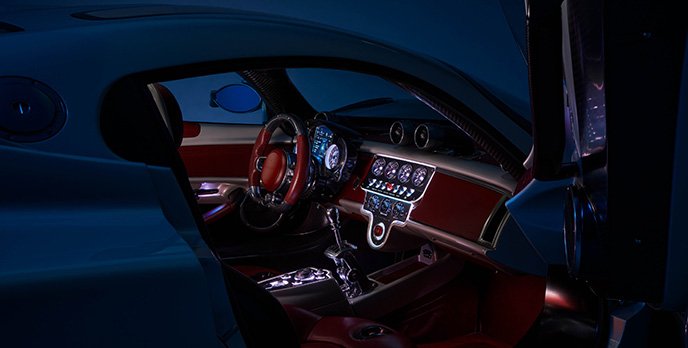
 Does Pagani make the best interiors in the world? If you are a fan of Renaissance era art, the answer would be a resounding yes Pagani has chosen to consolidate its existing strengths, to improve how its fibers are woven and to constantly invent new composite materials such as Carbo-Titanium and Carbo-Triax. On top of that, a new type of A-class carbon fibre has been developed specifically for aesthetic applications such as the bodywork, providing 38% of additional stiffness with the same density.
Does Pagani make the best interiors in the world? If you are a fan of Renaissance era art, the answer would be a resounding yes Pagani has chosen to consolidate its existing strengths, to improve how its fibers are woven and to constantly invent new composite materials such as Carbo-Titanium and Carbo-Triax. On top of that, a new type of A-class carbon fibre has been developed specifically for aesthetic applications such as the bodywork, providing 38% of additional stiffness with the same density.
Finally, we move on to the engine that powers the Utopia. The engine is a very familiar one which comes in the form of a 6.0-litre biturbo V12, specially built by Mercedes-AMG for Pagani. It delivers 864bhp and a tectonic plate shifting 1,100Nm of torque. Pagani states that in the engine's latest iteration, it revs higher and is both more flexible and powerful.
However, as we all know, quality triumphs over quantity in the world of Pagani. The Pagani Zonda and Pagani Huayra, the brand's first two cars, have been widely acclaimed as two of the finest cars to ever come out of Italy. To say that they imbue the very essence of passion and engineering excellence is an understatement to the genius that is Horacio Pagani.

Looking at photos of the Utopia, one of the key elements stands out: Simplicity. The Utopia has lines that are typical of a Pagani, but this time with more flowing and curvaceous design tones. The new car has very few aerodynamic add-ons but is more efficient than ever.
The Utopia incorporates the function of its appendices into its overall shape, achieving greater downforce and reduced drag solely by means of its design. This is unlike certain hypercars which possess numerous spoilers, disrupting the clean look of the car.

They are mounted on carbon-ceramic discs, coupled to brake calipers which have a new, lightened design.
The iconic Pagani titanium quad exhaust layout, a feature found on no other car, makes a return on the Utopia. It has a ceramic coating in order to dissipate heat efficiently, setting the weight just above 6kg for the entire system.

The steering wheel is fashioned from a solid aluminum block, from the spokes and hollow rim to the steering column boss, which contains the airbag. The pedals are also made from a single block of metal, while the gear lever mechanism is still exposed but more sophisticated than ever.
The Utopia also possesses active aerodynamics combined with electronically controlled shock absorbers. This ensures optimum dynamic behaviour in all driving conditions. The double-wishbone suspension, made from aerospace aluminium alloy, benefits from the lengthy development work carried out on the R, the track-only version of the Huayra.

Finally, we move on to the engine that powers the Utopia. The engine is a very familiar one which comes in the form of a 6.0-litre biturbo V12, specially built by Mercedes-AMG for Pagani. It delivers 864bhp and a tectonic plate shifting 1,100Nm of torque. Pagani states that in the engine's latest iteration, it revs higher and is both more flexible and powerful.
Pagani is a car company like no other. The Italian hypercar manufacturer which celebrates its 30th anniversary this year, has only just launched its third new car in the 30 years it has been in business. To put things into perspective, Ferrari launches around three all new cars in just a single year.
However, as we all know, quality triumphs over quantity in the world of Pagani. The Pagani Zonda and Pagani Huayra, the brand's first two cars, have been widely acclaimed as two of the finest cars to ever come out of Italy. To say that they imbue the very essence of passion and engineering excellence is an understatement to the genius that is Horacio Pagani.

 The design combines the best elements of the Zonda and Huayra, creating a match made in heaven... or Utopia? Enough of waxing lyrical about Pagani, let's talk about their latest masterpiece, the Pagani Utopia. The Utopia, as Horacio Pagani put it, aims to do things differently from what other high-end car makers are currently doing. He singled out three key elements which were missing from most cars, simplicity, lightness and pleasure of driving.
The design combines the best elements of the Zonda and Huayra, creating a match made in heaven... or Utopia? Enough of waxing lyrical about Pagani, let's talk about their latest masterpiece, the Pagani Utopia. The Utopia, as Horacio Pagani put it, aims to do things differently from what other high-end car makers are currently doing. He singled out three key elements which were missing from most cars, simplicity, lightness and pleasure of driving.
Looking at photos of the Utopia, one of the key elements stands out: Simplicity. The Utopia has lines that are typical of a Pagani, but this time with more flowing and curvaceous design tones. The new car has very few aerodynamic add-ons but is more efficient than ever.
The Utopia incorporates the function of its appendices into its overall shape, achieving greater downforce and reduced drag solely by means of its design. This is unlike certain hypercars which possess numerous spoilers, disrupting the clean look of the car.

 New shape incorporates appendices into overall shape, acheiving greater downforce and reduced drag while maintaining pure, unadultered lines Forged wheels with a turbine-shaped carbon fibre extractor are present, drawing hot air away from the brakes and reducing turbulence under the body.
New shape incorporates appendices into overall shape, acheiving greater downforce and reduced drag while maintaining pure, unadultered lines Forged wheels with a turbine-shaped carbon fibre extractor are present, drawing hot air away from the brakes and reducing turbulence under the body.
They are mounted on carbon-ceramic discs, coupled to brake calipers which have a new, lightened design.
The iconic Pagani titanium quad exhaust layout, a feature found on no other car, makes a return on the Utopia. It has a ceramic coating in order to dissipate heat efficiently, setting the weight just above 6kg for the entire system.

 The Utopia's gear shifter is pure Pagani with a skeletal-like movement which shows off the intricate mechanisms Moving on to the interior, Pagani claims that the cabin is more original than the car's exterior. There are no screens apart from the minimal display in front of the driver. The instruments are purely analog and each of the easy to read dials subtly reveals part of its mechanism as if it were revealing the skeleton movement.
The Utopia's gear shifter is pure Pagani with a skeletal-like movement which shows off the intricate mechanisms Moving on to the interior, Pagani claims that the cabin is more original than the car's exterior. There are no screens apart from the minimal display in front of the driver. The instruments are purely analog and each of the easy to read dials subtly reveals part of its mechanism as if it were revealing the skeleton movement.
The steering wheel is fashioned from a solid aluminum block, from the spokes and hollow rim to the steering column boss, which contains the airbag. The pedals are also made from a single block of metal, while the gear lever mechanism is still exposed but more sophisticated than ever.
The Utopia also possesses active aerodynamics combined with electronically controlled shock absorbers. This ensures optimum dynamic behaviour in all driving conditions. The double-wishbone suspension, made from aerospace aluminium alloy, benefits from the lengthy development work carried out on the R, the track-only version of the Huayra.

 Does Pagani make the best interiors in the world? If you are a fan of Renaissance era art, the answer would be a resounding yes Pagani has chosen to consolidate its existing strengths, to improve how its fibers are woven and to constantly invent new composite materials such as Carbo-Titanium and Carbo-Triax. On top of that, a new type of A-class carbon fibre has been developed specifically for aesthetic applications such as the bodywork, providing 38% of additional stiffness with the same density.
Does Pagani make the best interiors in the world? If you are a fan of Renaissance era art, the answer would be a resounding yes Pagani has chosen to consolidate its existing strengths, to improve how its fibers are woven and to constantly invent new composite materials such as Carbo-Titanium and Carbo-Triax. On top of that, a new type of A-class carbon fibre has been developed specifically for aesthetic applications such as the bodywork, providing 38% of additional stiffness with the same density.
Finally, we move on to the engine that powers the Utopia. The engine is a very familiar one which comes in the form of a 6.0-litre biturbo V12, specially built by Mercedes-AMG for Pagani. It delivers 864bhp and a tectonic plate shifting 1,100Nm of torque. Pagani states that in the engine's latest iteration, it revs higher and is both more flexible and powerful.
However, as we all know, quality triumphs over quantity in the world of Pagani. The Pagani Zonda and Pagani Huayra, the brand's first two cars, have been widely acclaimed as two of the finest cars to ever come out of Italy. To say that they imbue the very essence of passion and engineering excellence is an understatement to the genius that is Horacio Pagani.

Looking at photos of the Utopia, one of the key elements stands out: Simplicity. The Utopia has lines that are typical of a Pagani, but this time with more flowing and curvaceous design tones. The new car has very few aerodynamic add-ons but is more efficient than ever.
The Utopia incorporates the function of its appendices into its overall shape, achieving greater downforce and reduced drag solely by means of its design. This is unlike certain hypercars which possess numerous spoilers, disrupting the clean look of the car.

They are mounted on carbon-ceramic discs, coupled to brake calipers which have a new, lightened design.
The iconic Pagani titanium quad exhaust layout, a feature found on no other car, makes a return on the Utopia. It has a ceramic coating in order to dissipate heat efficiently, setting the weight just above 6kg for the entire system.

The steering wheel is fashioned from a solid aluminum block, from the spokes and hollow rim to the steering column boss, which contains the airbag. The pedals are also made from a single block of metal, while the gear lever mechanism is still exposed but more sophisticated than ever.
The Utopia also possesses active aerodynamics combined with electronically controlled shock absorbers. This ensures optimum dynamic behaviour in all driving conditions. The double-wishbone suspension, made from aerospace aluminium alloy, benefits from the lengthy development work carried out on the R, the track-only version of the Huayra.

Finally, we move on to the engine that powers the Utopia. The engine is a very familiar one which comes in the form of a 6.0-litre biturbo V12, specially built by Mercedes-AMG for Pagani. It delivers 864bhp and a tectonic plate shifting 1,100Nm of torque. Pagani states that in the engine's latest iteration, it revs higher and is both more flexible and powerful.
Latest COE Prices
October 2025 | 1st BIDDING
NEXT TENDER: 23 Oct 2025
CAT A$128,105
CAT B$141,000
CAT C$74,301
CAT E$140,009
View Full Results Thank You For Your Subscription.





















